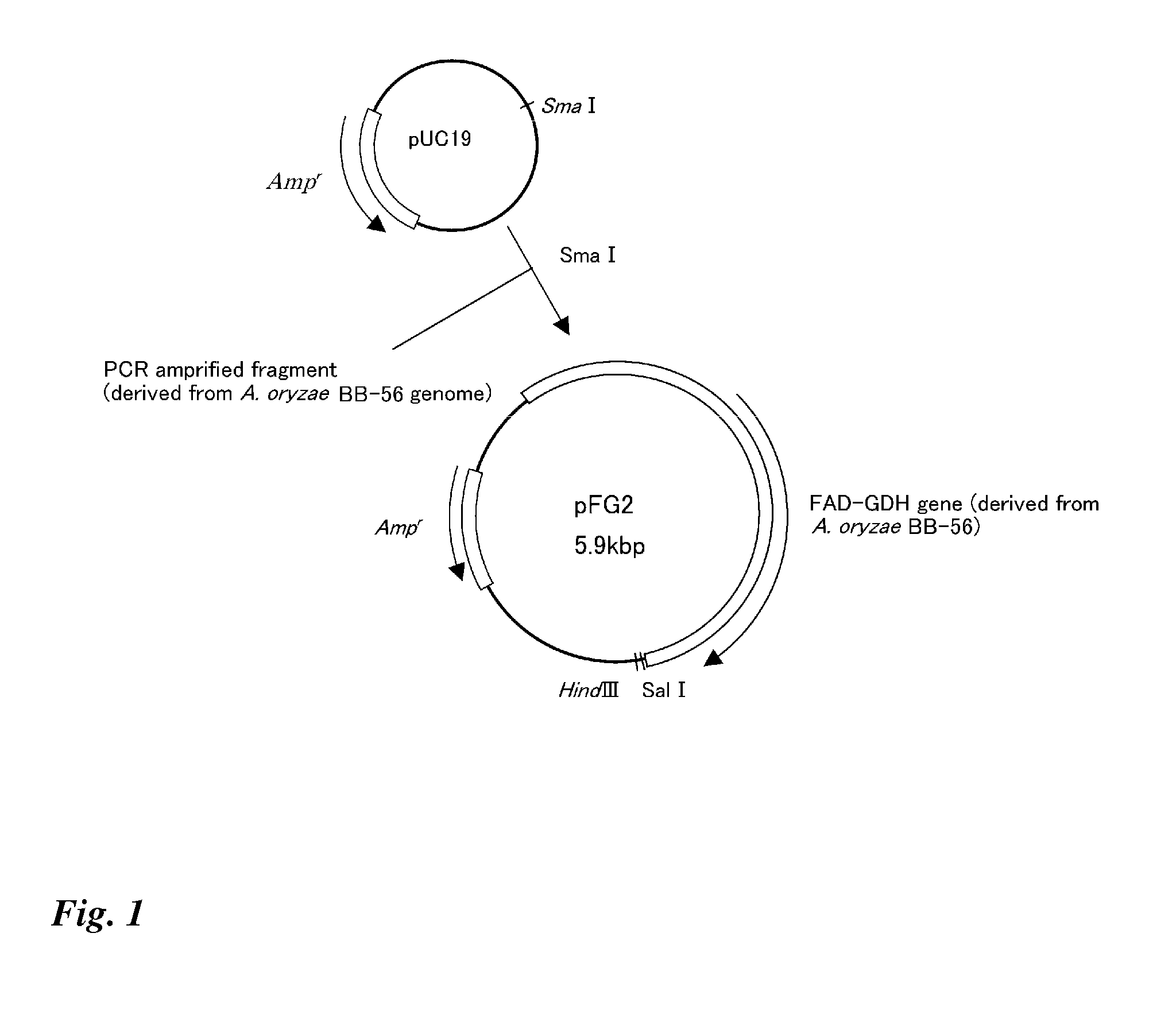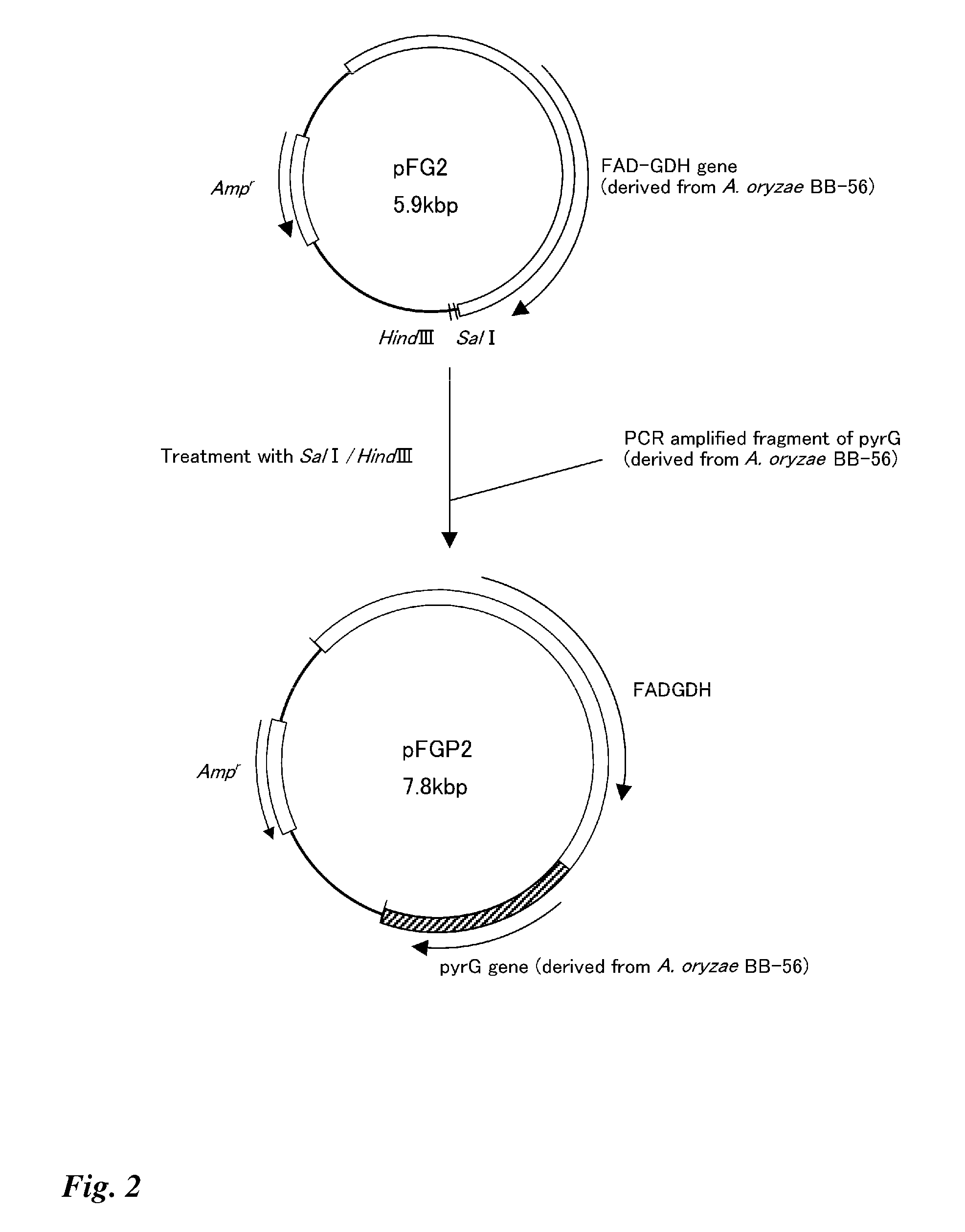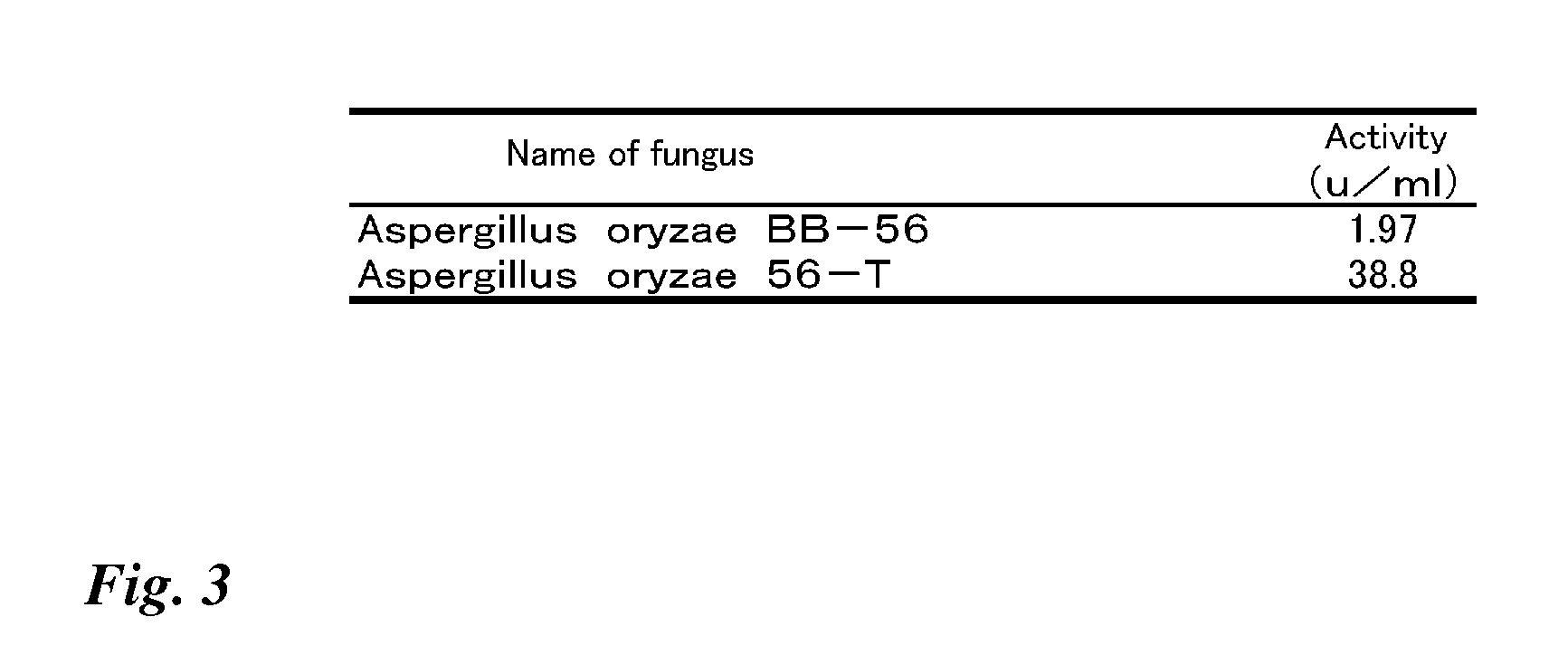Transformant transfected with flavin adenine dinucleotide-binding glucose dehydrogenase gene and method for producing flavin adenine dinucleotide-binding glucose dehydrogenase using the same
a technology of adenine dinucleotide binding and adenine dinucleotide, which is applied in the direction of biochemistry, microorganisms, enzymes, etc., can solve the problems of difficult extraction and isolation operations, easy damage to the fad-gdh product, etc., to achieve excellent selectivity for glucose, accurate glucose level measurement, and excellent fad-gdh produ
- Summary
- Abstract
- Description
- Claims
- Application Information
AI Technical Summary
Benefits of technology
Problems solved by technology
Method used
Image
Examples
example 1
Culture of Aspergillus oryzae BB-56
[0087]According to the following procedure, Aspergillus oryzae BB-56 was cultured to produce FAD-GDH. 50 ml of a medium for preliminary culture, which was constituted with the components below, was dividedly charged in a 300 mL-volume conical flask and sterilized at 121° C. and 0.12 MPa for 20 minutes. The medium was cooled to room temperature, and Aspergillus oryzae BB-56 was then inoculated and cultured at 30° C. and 200 rpm for 3 days.
(Medium Components for Preliminary Culture)
[0088]Yeast extract (Becton, Dickinson Company) 0.2% (w / v)
[0089]Soybean peptone (DMV Co.) 1.0% (w / v)
[0090]Glucose (Wako Pure Chemical Industries, Ltd.) 2.0% (w / v)
[0091]KH2PO4 (Wako Pure Chemical Industries, Ltd.) 0.1% (w / v)
[0092]MgSO4.7H2O (Sigma-Aldrich Japan K.K.) 0.05% (w / v)
[0093]Medium pH 5.7
[0094]FAD-GDH was produced with a medium for main culture constituted with the components below. 50 ml of the medium for main culture was dividedly charged in a 300 mL-volume conic...
example 2
Purification of Aspergillus oryzae BB-56-derived FAD-GDH
[0102]FAD-GDH was purified under the following conditions. Fungus bodies and other solid contents in the culture liquid were removed by diatomite filtration of the culture liquid obtained as described above. The purified liquid obtained through the operation was desalinated and concentrated with an ultrafilter membrane. The concentrated liquid was subjected to salting out with 90% saturated ammonium sulfate and the centrifuged supernatant was desalinated and concentrated with an ultrafilter membrane. The desalinated and concentrated liquid was applied to a CM Sepharose Fast Flow (Amersham Biosciences Co.) equilibrated with a 10 mM Mcllvaine buffer solution at pH 5.5 to adsorb FAD-GDH to a column. The column was washed with a 10 mM Mcllvaine buffer solution at pH 5.5 and FAD-GDH was eluted with a 10 mM Mcllvaine buffer solution containing 0.1 M of NaCl at pH 5.5 to recover a FAD-GDH active fraction. The recovered active fraction...
example 3
Identification of Partial Amino Acid Sequence of Aspergillus oryzae BB-56-Derived FAD-GDH
[0103]A partial amino acid sequence of Aspergillus oryzae BB-56-derived FAD-GDH was identified as follows.
(1) Isoelectric Fractionation of FAD-GDH
[0104]3 mL of the purified FAD-GDH solution obtained in Example 2 was charged in a dialysis tube and immersed in purified water to perform dialysis at 4° C. for one night. This dialyzed sample was supplied to glycerol density gradient gel electrophoresis. Energization was performed at 5° C. at a low voltage of 400 V for 48 hours with a column volume of 110 mL using a carrier ampholyte (Pharmalyte 3-10 for IEF (Amersham Biosciences Co.)). After energization, the sample was recovered and a pH and a FAD-GDH activity of each fraction were measured to collect an active fraction.
(2) Preparation of Sample for Partial Amino Acid Sequence Analysis
[0105]The purified FAD-GDH obtained in the above described (1) was supplied to SDS-PAGE using a gel, PAG Mini “DAIIC...
PUM
| Property | Measurement | Unit |
|---|---|---|
| pH | aaaaa | aaaaa |
| pH | aaaaa | aaaaa |
| molecular weight | aaaaa | aaaaa |
Abstract
Description
Claims
Application Information
 Login to View More
Login to View More - R&D
- Intellectual Property
- Life Sciences
- Materials
- Tech Scout
- Unparalleled Data Quality
- Higher Quality Content
- 60% Fewer Hallucinations
Browse by: Latest US Patents, China's latest patents, Technical Efficacy Thesaurus, Application Domain, Technology Topic, Popular Technical Reports.
© 2025 PatSnap. All rights reserved.Legal|Privacy policy|Modern Slavery Act Transparency Statement|Sitemap|About US| Contact US: help@patsnap.com



